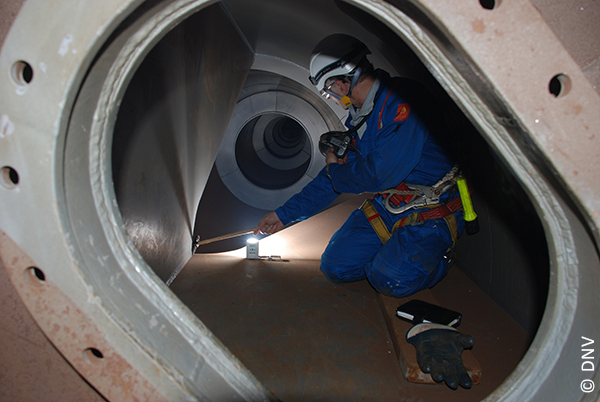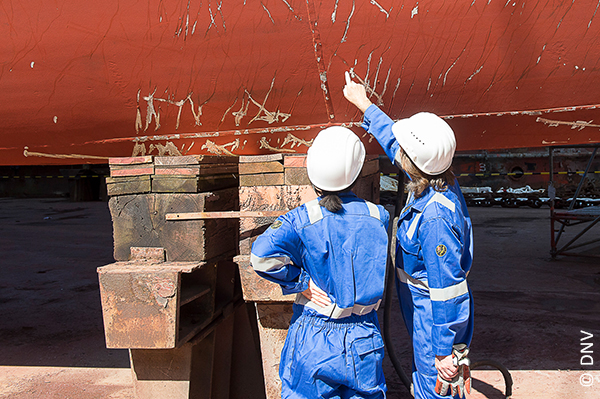
|
DNV and PROSTEP develop 3D PDF solution for surveys in shipbuildingBy Matthias Grau For years, classification societies and shipyards have been looking for ways to move away from drawings and make the class approval process and processes, such as making the site survey model-based. Now, with the support of PROSTEP, DNV is making progress. Together, we have developed a solution to provide surveyors with 3D models of the hull structure in a 3D PDF container that can be used offline. 
With approximately 13,000 employees and a turnover of more than NOK 25 billion, DNV is the world's leading classification society for the maritime industry Headquartered in Høvik, just outside Oslo, DNV has a presence in over 100 countries and is structured into six business areas: Maritime, Energy Solutions, Digital Solutions, Supply Chain & Product Assurance, Business Assurance and The Accelerator. DNV's Maritime business area, which employs about 3,300 people worldwide, is responsible for classifying ships and mobile offshore facilities, among other things. Classification societies like DNV develop and apply technical standards for the design, construction, and surveying of ships, and carry out surveys on board ships. The approval of a classification society can enable shipping companies to obtain insurance for their ships and gain permission to call at certain ports or transit sea areas. To obtain class approval, shipyards today send quantities of large-format drawings to DNV or other classification societies, which use these documents to check whether the ships will withstand the stresses and strains at sea and comply with statutory regulations related to things like safety and emissions. Tool for the Digital 3D Site Survey In a way, the development project with PROSTEP is the logical consequence of the OCX initiative, as Ole Christian Astrup, Senior Principal Specialist at DNV Maritime says. "The shipyards are not only contracting us for classification but also for surveying the construction phase. If we exchange annotated 3D models with them instead of drawings in the future, we also must think about how to make these 3D models usable for the follow-up processes at the construction site. The challenge is to give surveyors a tool for drawing-less 3D site survey that they can use in a big steel cage that's dirty and pretty dark, and where there's often no mobile or network connectivity." 
Surveyors oversee the construction process at the shipyard and ensure that the ship is built as designed and approved by the class approval experts. For this purpose, DNV usually maintains a small office on the shipyard premises with a team of three to five employees. The basis for their work to date has been vast quantities of large-format drawings, often with comments from colleagues in the plan approval department. With these drawings under their arms, they go on block inspections and check, for example, the thickness of the steel plates or the quality of the welds. A key requirement for the 3D digital site survey solution was that users could access the 3D models offline from a mobile device and navigate them conveniently. They also needed access to the comments from the approval process, which are managed in a separate application. In the solution jointly developed by DNV and PROSTEP 3D models, supplementary attributes and comments are automatically transferred into 3D PDF containers. To keep the development effort manageable, the project only envisaged visualization of the information in the first step, but not interaction with the comments. 
Positive Experience with 3D PDF Technology DNV decided to work with PROSTEP on the development of the 3D PDF-based solution because both companies had been involved in a pilot project with MEYER WERFT which had a similar focus a few years ago. At that time, the aim was to provide the classification society with 3D PDF containers containing CATIA models of the shipyard for class approval. "As a result, we knew that PROSTEP's 3D PDF technology would meet our requirements and that PROSTEP had the capability to develop this solution for us," says Astrup. "We also came to appreciate the company's shipbuilding expertise during the OCX project." The solution now developed builds on the experience gained from the project with MEYER WERFT, but does not use native CAD models. Instead, it uses the OCX data and STEP models derived from it. First, the geometry models encoded and topologically described in OCX are converted into explicit 3D models in DNV's Nauticus system. These models, together with non-geometric information from OCX such as plate thickness or profile cross-section type, are then automatically embedded in the structured 3D PDF template developed by PROSTEP. OCX also contains some auxiliary geometry visualizing the frame grid. It facilitates the orientation in the relatively large 3D models for the surveyors, who do not think in meters but in frame numbers and decks. However, this auxiliary geometry is only described in numerical form in OCX. The PROSTEP solution converts it into STEP geometry before filling the 3D PDF template and automatically links it to the model data of the ship's hull provided by DNV. 
The 3D PDF solution provides the site surveyors with the classic measurement and filter functions that Adobe Reader provides by default. However, PROSTEP has moved these functions to several easy-to-use buttons so that users can navigate the model data in an environment with poor visibility. In addition, the solution automatically embeds class approval comments from the DNV’s Nauticus system into the 3D PDF container. The comments are attached directly to specific 3D components, which are highlighted when the corresponding comment is clicked. Professional Project Management One of the challenges of the project was to find a good collaboration mode with all the stakeholders in order to align the requirements with them in the preparation phase and get their feedback later on during the testing phase. This was the prerequisite for being able to implement the project in agile sprints. “Thanks to its professional project management, PROSTEP managed the project very efficiently and on time and budget”, praises Astrup. This was especially true for the test phase with several testers in different countries and time zones. DNV employs 300 to 400 surveyors worldwide, who oversee the construction of around 100 new vessels per year. The new 3D site survey solution provides them with all the information they need for their work in a single place, so they no longer have to search through dozens of drawings. This saves them time. Astrup therefore believes that the real benefit for surveyors will come when they can interact directly with the 3D model. This might include the ability to close comments or change their status after an inspection was satisfactory or to create new comments and add observations if surveyors discover something not compliant on-site. "The potential of the solution is huge," he concludes. This might not only be of interest for classification societies but also for ship owners and operators, which also send surveyors on the ships to monitor the construction process or operational state. |
|
| © PROSTEP AG | ALL RIGHTS RESERVED | IMPRINT | PRIVACY STATEMENT | YOU CAN UNSUBSCRIBE TO THE NEWSLETTER HERE. |

